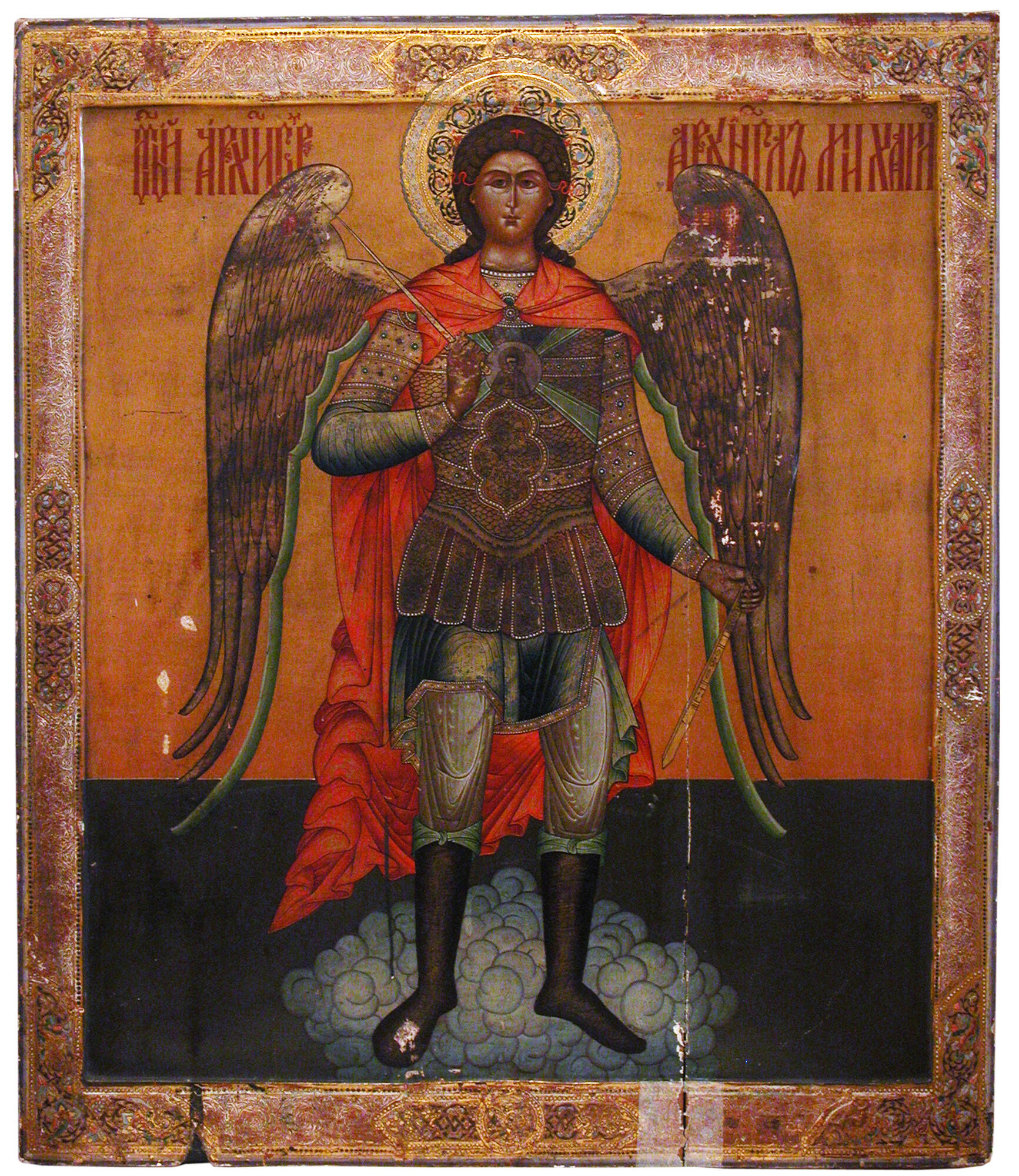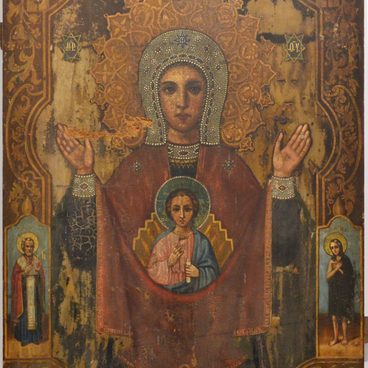In the Christian tradition archangels occupy the upper category in the angels’ hierarchy. They do special God’s assignments for the sake of building the Kingdom of heaven on Earth. The Orthodox tradition separates eight archangels: Michael, Gabriel, Raphael, Uriel, Selaphiel, Jegudiel, Barachiel, and Jerahmeel.
Archangel Michael takes pride of place among them. In translation from Hebrew the name Michael means ‘who is like God? ’ According to the Bible story, archangel got his name after his fight with angel Dennitsa, who dared to fight with God. Later on Dennitsa lost his angelic name and became known as Satan or Devil. Archangel shouted, ‘who is like God? ’ applying to the angelic army. After the victory he got the name Michael. He was the only one to be given a special rank of Taxiarch, which means ‘the head of the saint army of Archangels and Angels’. In the Orthodox tradition he is a saint patron of the earthly warriors.
There’s a few variations of the Archangel’s iconography. In this icon he is depicted full size in the image of Taxiarch, a mighty warrior leader. This is how he appeared to Joshua in order to reveal the mystery of his victory over Jericho. The archangel is dressed in armor and holds a sword in his right hand and sheath in his left hand. In its style Michael’s clothes are similar to the ones of a Roman legionary. Such depiction had Byzantine roots, but it’s canonic in the Orthodox Christianity as well.
The icon was created in the late 19th century in one of the icon painting studios of Vyaznikovsky district in Vladimir Governorate. The Palekh icons stand out of the rows of other icon painting schools with their special features. The icon painters from Palekh and Mstyora used a big quantity of gold paint while painting the ornaments and clothes, which gave more solemnity to the images. The icons of that school are various in depiction of the details. On the icon from the collection of the The Kurgan Regional Art Museum the armor was painted with ornament imitating niello on gold technique. The edges and nimbus were decorated with the complicated engraved ornament with enamel imitating painting imitating.
The turn of the 20th century was marked with the art nouveau epoch in art. Despite the fact that it manifested itself most evidently in the secular art, its influence touched the Orthodox icon painting as well. The canonic colour combinations were mixed with the new tones: purple, pink, grey. Along with tempera and oil such new paints as enamels and lacquer-like paint imitating enamel were used. In general they were used for painting nimbuses and ornaments on the edges. One of the characteristic features of art nouveau style was its tending to the world of nature. In icons it can be seen in the abundance of floral ornaments in decoration of the clothes and background. In this icon the ornament has a sacral meaning. According to the legend, the Almighty let the Archangel Michael guard the gates of heaven, that is why his nimbus has a floral ornament depicted on it, which symbolizes the Garden of Eden.
Archangel Michael takes pride of place among them. In translation from Hebrew the name Michael means ‘who is like God? ’ According to the Bible story, archangel got his name after his fight with angel Dennitsa, who dared to fight with God. Later on Dennitsa lost his angelic name and became known as Satan or Devil. Archangel shouted, ‘who is like God? ’ applying to the angelic army. After the victory he got the name Michael. He was the only one to be given a special rank of Taxiarch, which means ‘the head of the saint army of Archangels and Angels’. In the Orthodox tradition he is a saint patron of the earthly warriors.
There’s a few variations of the Archangel’s iconography. In this icon he is depicted full size in the image of Taxiarch, a mighty warrior leader. This is how he appeared to Joshua in order to reveal the mystery of his victory over Jericho. The archangel is dressed in armor and holds a sword in his right hand and sheath in his left hand. In its style Michael’s clothes are similar to the ones of a Roman legionary. Such depiction had Byzantine roots, but it’s canonic in the Orthodox Christianity as well.
The icon was created in the late 19th century in one of the icon painting studios of Vyaznikovsky district in Vladimir Governorate. The Palekh icons stand out of the rows of other icon painting schools with their special features. The icon painters from Palekh and Mstyora used a big quantity of gold paint while painting the ornaments and clothes, which gave more solemnity to the images. The icons of that school are various in depiction of the details. On the icon from the collection of the The Kurgan Regional Art Museum the armor was painted with ornament imitating niello on gold technique. The edges and nimbus were decorated with the complicated engraved ornament with enamel imitating painting imitating.
The turn of the 20th century was marked with the art nouveau epoch in art. Despite the fact that it manifested itself most evidently in the secular art, its influence touched the Orthodox icon painting as well. The canonic colour combinations were mixed with the new tones: purple, pink, grey. Along with tempera and oil such new paints as enamels and lacquer-like paint imitating enamel were used. In general they were used for painting nimbuses and ornaments on the edges. One of the characteristic features of art nouveau style was its tending to the world of nature. In icons it can be seen in the abundance of floral ornaments in decoration of the clothes and background. In this icon the ornament has a sacral meaning. According to the legend, the Almighty let the Archangel Michael guard the gates of heaven, that is why his nimbus has a floral ornament depicted on it, which symbolizes the Garden of Eden.


